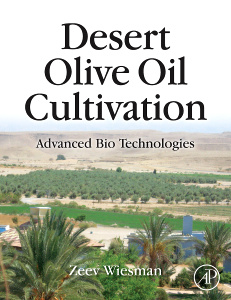Description
Desert Olive Oil Cultivation
Advanced Bio Technologies
Author: Wiesman Zeev
Language: English
Subjects for Desert Olive Oil Cultivation:
Keywords
desertification; oil extraction; fatty acids; irrigation; harvesting; waste; marketing
416 p. · 19x23.3 cm · Hardback
Description
/li>Contents
/li>Readership
/li>Comment
/li>
Due to the adverse stress conditions typical of olive cultivation in desert conditions, the olive tree is responding with production of high levels of antioxidant substances. Among these substances are polyphenols, tocopherols, and phytosterols. Studies have shown that saline irrigated varieties of olives have demonstrated advantages over those irrigated with tap water.
This is just one of the aspects of desert cultivation of olives that is covered in Desert Olive Oil Advanced Biotechnologies. Based on 20 years of research, the book expounds on the appropriate selection of olive varieties with high productivity and oil quality, the impact of foliar nutrition on decreasing alternate bearing and increasing fruit quality, improving efficiency of mechanical harvesting, and increasing efficiency of oil extraction and oil quality regulating analysis.
Students interested in desert and saline cultivation, chemical analysis and biotechnological manipulation.
- Addresses olive cultivation methods for semi-arid environments
- Focuses on intensive cultivation using saline and municipal waste recycled irrigation water and their significant impact on the production and nutritional value of olive oil
- Integrated and multidisciplinary approaches providing a comprehensive view of the desert olive industry
- Provides key considerations including ecological, biotechnological, agricultural and political impacts
These books may interest you

The Extra-Virgin Olive Oil Handbook 176.49 €



